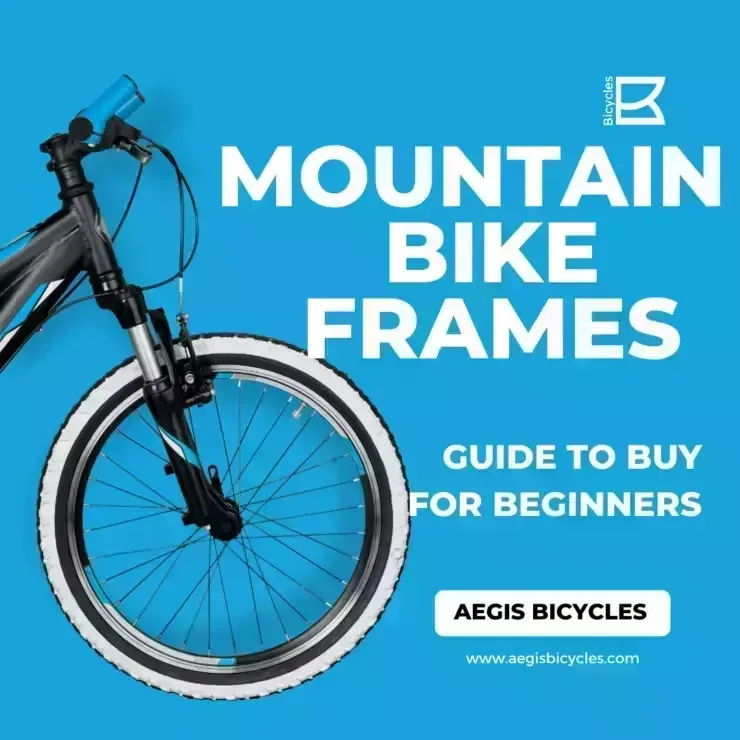Guide To Buy Mountain bike frames: are the most critical part of the riding experience. A good one can make any ride comfortable and satisfying, while a bad one can turn the perfect trail into a house of horrors. Picking the right frame is essential to maximize the fun and enjoyment of each run, whether it starts at the top of a ski lift and ends at the base of the mountain, or is a fun local trail that takes a rider through hills and over divots.

There are numerous frames to choose from, and each one has its fans and its detractors. It can be hard to pick out the best option for your needs and to find one at the right price to fit your budget.
Mountain bike frames are made from a variety of different materials, each of which has different properties that help them perform specific functions. Whether you’re interested in a titanium mountain bike frame, a carbon mountain bike frame, or a frame made from aluminum or steel, all you need to know about what each of these materials can do for you as a rider is here as well. Each has their attributes and their drawbacks, and this article will make those clear.
29er Mountain Bike Frames
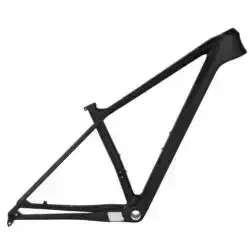
The term “29er” refers to a bike that is built to use 700c or ISO 622 mm wheels instead of the standard 559mm wheels. A 29-inch mountain bike frame is guaranteed to cause spirited conversation, both from those who consider it an improvement and those who disagree.
People who use 29er mountain bike frames cite attributes like the larger wheels that can roll over roadblocks and through the muck and mud. They also may make it easier to gain traction on corners, and their added height may provide a better experience for a taller rider. 29er enthusiasts will also say that there is less rolling resistance and wear on the tires, though you’ll get some disagreement on those points from fans of the traditional frames.
For a long time, it was hard to find tires and parts for 29ers, but that is changing as the style becomes more popular. A number of companies make 29er mountain bike frames, including Specialized, Intense, Vassago and Niner.
A 29er mountain bike frame may be worth checking out, as they can be great choices for many riders. Before you buy, check out the information on this all-inclusive mountain bike websites for information and the best prices on all the big brands.
Downhill Mountain Bike Frames
Downhill mountain bike frames are designed to provide performance and comfort over difficult terrain that can feature jumps, drops, boulders and divots. As such, they are specially designed specifically for that kind of use.
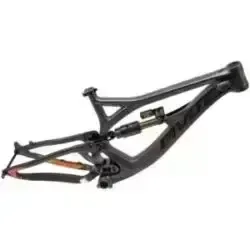
The typical downhill mountain bike frame is strong, and getting lighter in every generation, though they are typically heavier when designed for all-terrain riding because they have to have added heft and stability to handle obstacles at high rates of speed.
That usually means using alloys, with carbon and aluminum among the more popular. Most frames allow seven or more inches of suspension travel in order to handle the bumps and bruises of the typical course.
In addition, the downhill mountain bike frames have slack head angles, up to 64 degrees in many cases. That extra sag inspires greater traction, but it doesn’t make these frames particularly useful for a bike designed for more traditional commuting.
Downhill mountain bike frames are built to go down a mountain, and a good one can make the trip down from the ski lift into a fun experience. But don’t try climbing back up a hill with one — they’re not called uphill mountain bike frames for a reason.
Freeride Mountain Bike Frames

Freeride mountain bike frames are similar to those of downhill bikes but are designed to be more versatile.
A freeride mountain bike frame is generally constructed from aluminum or steel, with steeper head tube angles and shorter wheelbases to increase their stability in low-speed courses. It generally has a rear suspension system, mainly single-pivot systems for extra strength.
In addition, single-crown forks being the most popular among manufacturers. The appeal of the single-crown fork is that most modern versions are nearly as strong as a dual-crown fork, but permits a narrower steering diameter and makes it easier to do airborne tricks. It’s also easier to pedal than a downhill mountain bike frame, and more versatile for use on cross-country trails courses as well.
Most freeride mountain bike frames are smaller than a typical downhill frame, and lighter as well. However, there are other models that are heavier, with strength and durability taking precedence over lightness and maneuverability. Either way, these frames are designed to make it easier to do tricks and take on obstacles with style.
Before buying a freeride mountain bike frame, check out the information on this comprehensive website for the best information and prices.
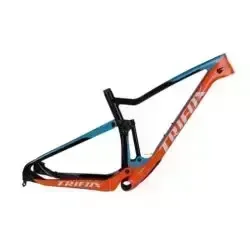
Full Suspension Mountain Bike Frames
Full suspension mountain bike frames are so called because they have a front fork and rear suspension both integrated into the frame. That gives them a greater ability to provide comfort and performance over rough terrain, as the rear suspension helps absorb the shocks of the road while also helping the rider control the bike through the bumps and divots. Commonly found in aluminum, carbon, steel and titanium, there are numerous options available to fit any need and budget.
Except at the titanium end of the spectrum (i.e. the highest price point), full suspension mountain bike frames tend to be heavier than other types, because of the additional rear suspension. That extra weight won’t be a big deal for most riders, but energy does get lost in the rear suspension, so that added comfort, downhill speed, and ability to control the bike is paid for by a harder uphill or climb.
Other factors to consider: a full suspension mountain bike frame is designed for rough and hilly terrain, so if you are looking for a pavement bike that can help with the commute to work, look for a bike that offers a suspension lock-out that will freeze out the rear suspension as needed. That will create a much smoother ride on friendly ground.
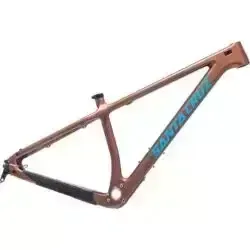
Hardtail Mountain Bike Frames
Despite the name that implies an uncomfortable ride, there’s a lot to like about hardtail mountain bike frames.
A hardtail mountain bike frame gets its name because it doesn’t have a rear suspension integrated into the frame. That makes it lighter and easier to deal with because there are fewer parts to worry about breaking and there are no worries that the rear suspension will break in the middle of a ride. It also makes the hardtail bikes cheaper, both to buy and to maintain.
Of course, the lack of a read suspension can make for a less comfortable ride, but that’s not necessarily the case. A hardtail with an s-bend seat stays, a good suspension fork, and shaped tubes can make for extended comfort even on longer rides. Moreover, the hardtail mountain bike frame is ideally suited to handling rougher terrain, and even the cheaper models nowadays are constructed to offer both performance and comfort.
If you plan on taking your bike off-road, a hardtail bike is probably the best choice, and they’re great for trail riding as well. There are plenty of great bargains on hardtail mountain bike frames available, and checking this comprehensive website should help you find what you are looking for.
Single Speed Mountain Bike Frames
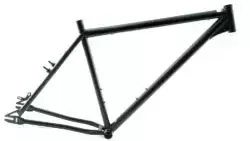
It’s more than a little bit old school, but single speed mountain bike frames are becoming more popular as riders start to place things like exercise or getting a particular kind of rider experience over the efficiency of a multi-speed ride.
As the name suggests, a single-speed mountain bike has just one gear ratio, which a rider should pick based on their ability and general terrain. Most single-speeds are steel, for greater comfort and durability.
There is a lot to recommend about single speed mountain bike frames. They tend to be lighter, for example, since there is no need for the weight of all the gear that goes into the gearshift mechanisms. They’re also deceptively sturdy, particularly on off-road courses, since there’s less to catch on stray underbrush.
A key to the success of a single speed mountain bike frame is to make sure they are suited to the rider. Someone who isn’t fit, for example, is probably better off with something that allows them to shift into a lower gear when needed. It also adds to the degree of difficulty of steep climbs, so trying to go up an actual mountain is more of a challenge in a single speed. But there’s something to be said for the freedom that comes with riding with the freedom to not worry about shifting gears.
Many companies make single speed mountain bike frames, and you can find links to them and find out what the best prices are on this comprehensive mountain bike website.
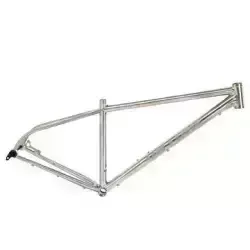
Steel Mountain Bike Frames
What’s so good about them? Steel mountain bike frames are among the classic designs, because of the top qualities that the material offers.
There are a lot of things to like about steel mountain bike frames, which is why despite all the fancy titanium and carbon models out there steel never really goes out of style. For starters, they are the most durable frames available. A steel mountain bike can take a lot of punishment and still provide a smooth ride with minimal vibrations for many years.
Comfort is also a big asset. Steel mountain bike frames have a well-deserved reputation for comfort and offer more flex than stiff materials like aluminum. A long ride on a steel frame over bumpy terrain is liable to leave a rider less sore than a similar ride on other materials.
One thing to remember about steel mountain bike frames is that they require maintenance. Any chips in the paint, for example, have to be attended to quickly or they will rust. Most steel frames are also heavier than most other frame materials, and if you’re looking for a newer steel frame engineered to be as light as titanium, you’ll pay a lot extra for that privilege.
Steel mountain bike frames are great choices because of their affordability, comfort, and durability. When in doubt, go into any bike shop or on any group ride and you’ll hear the phrase “steel is real.” Among a certain segment of bike lovers, there’s nothing better.
Aluminum Mountain Bike Frames
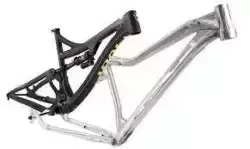
Aluminum mountain bike frames are generally lighter and cheaper than Steel mountain bike frames. They often are stiffer and are easier to use as a climbing bike, though they are somewhat less comfortable (aluminum-carbon alloys are designed to alleviate that, but those are pricier). A longer ride on an aluminum bike that’s not well-fitted is going to create some soreness and fatigue, but its lightness makes it easier to transport. With a good suspension system — a must-have in any frame — an aluminum mountain bike frame can be perfectly comfortable.
Another asset in aluminum mountain bike frames is that they are easy to maintain. But one drawback is that they are somewhat less durable, both because the metal isn’t as strong and because it doesn’t flex very much. Extended wear, whether it’s a rough course or the repetition of extended rides, can cause the frame to break, and it’s very difficult to repair. Aluminum bike frames are cheaper, but if you ride a lot you will probably have to replace them more often.
Carbon Fiber Mountain Bike Frames
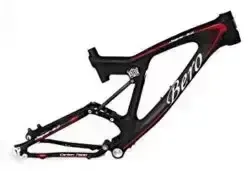
How good are they? Carbon Fiber Mountain Bike frames are among the best on the market. They have inherent properties that make them easy to work with, and as a result, some of the best mountain bike frame designs available rely on carbon as the construction material.
One benefit of carbon fiber mountain bike frames is that they are strong and stiff while also remaining light. Made from fibers braided together with a strong epoxy, the grain of each sheet of carbon fiber is crossed to form a hard and strong surface with a great weight-to-strength ratio that allows it to perform well with less bulk.
They can be molded into innovative frame shapes easier than titanium, steel, or aluminum. A flat carbon fiber frame will be aerodynamic, while a square design will be stronger. Moreover, carbon fiber mountain bike frames don’t rust, which is one less maintenance worry.
The one caveat with carbon mountain bike frames is that they are a little less durable. They crack easier than other materials, and once a carbon frame is cracked its useful lifespan is pretty much over. They can be repaired, but the fix is usually temporary and causes extra frame stress that will ultimately cause it to need to be replaced.
But for a serious cyclist looking for a light and effective frame, a carbon fiber mountain bike frame can be tough to beat.
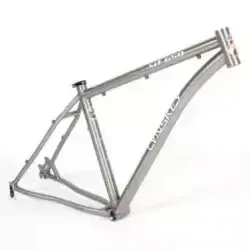
Titanium Mountain Bike Frames
For a mountain bike that’s both light and capable of handling anything, nature has to offer regardless of the cost, titanium mountain bike frames can be a great option.
Titanium mountain bike frames are extremely light because titanium itself is a light and workable. But titanium is also durable, both in the short term and long term, and a good mountain bike frame needs durability to survive the punishment it may take on a typical course. A good titanium mountain bike frame can handle any mountain, and also handle the sustained rigor of difficult riding over time.
Among the other popular materials, steel is durable but heavy, while aluminum is light but more susceptible to damage. A titanium frame combines the best of both materials. Plus it resists corrosion, so it’s easier to care for, and the natural shine of the titanium mountain bike frames makes it stand out at the starting line as well.
That’s why titanium racing bikes are popular among the professional riders. There’s another reason for that as well — titanium mountain bike frames are expensive. But the pros want only the best to race down the toughest courses against the best competition, and many of the best options are made of titanium.
Size Guide
How to pick the right size frame for your mountain bike? Picking the right mountain bike frame size is critical for an enjoyable riding experience. With a few simple bits of information, it’s easy enough to know what size frame is right for you.
Mountain bikes are measured in the distance from the center of the crank to the top of the seat tube frame. That is the generally accepted way of measuring, but be careful: a few manufacturers measure from the intersection of the top tube and seat post to the crank axle instead, which gives a slightly different number. Also, some manufacturers just go with generic small, medium and large designations, so it’s important in those cases to get the exact inch length before buying.
To choose the right mountain bike frame size, the two important facts to know are your height and your inseam measurements. The inseam measurement is the most critical, and it’s best if you are barefoot at the time. If you don’t know the number offhand, there are a number of ways to measure it yourself. Among them: stand up against a wall with a book between your legs, pressed up against your pelvic bone, and mark on the wall where the top of the book is. That’s your inseam.
Someone between 4’11”-5’3″, with a 25-27-inch inseam, is generally recommended for a bike frame size of between 13-15 inches. Someone 5-3 to 5-7 with a 27-29 inch inseam would be more comfortable in a 15-17 inch mountain bike frame. If you are 5-7 to 5-11, with a 29-31 inch inseam, a 17-19 inch mountain bike frame is best.
Taller riders naturally need a bigger frame. Someone who is 5’11” to 6’2″ with a 31-33 inch inseam would get a 19 to 21-inch mountain bike frame. At 6-2 to 6-4, with a 33-35 inch inseam, 21-23 inch bike frames work, and someone taller than 6-4 with an inseam 35 inches or greater needs something a bit larger, generally more than 23 inches.
That works for most riders, but there are some exceptions. If you are a rider who is more aggressive going down the mountain and need something more maneuverable, a frame that’s a size smaller may meet your needs more. Also, bikes made for women are sized slightly differently, so be sure and double-check to make sure the fit is the appropriate one.
Conclusion
And for anyone looking for the best bargains available, look no further. There are places to buy cheap mountain bike frames, used mountain bike frames, and discount mountain bike frames.
It’s that time of year again when the lure of the mountain bike trail becomes hard to resist. Here’s where all of your mountain bike frame needs can be met, allowing you to make the most of every ride.
